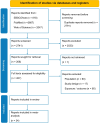Associations between device-measured physical activity and performance-based physical function outcomes in adults: a systematic review and meta-analysis
- PMID: 40017839
- PMCID: PMC11812739
- DOI: 10.1136/bmjph-2023-100000
Associations between device-measured physical activity and performance-based physical function outcomes in adults: a systematic review and meta-analysis
Abstract
This systematic review and meta-analysis aimed to examine the association between device-measured physical activity (PA) and performance-based measures of physical function (PF). Databases searched included CINAHL, Embase, MEDLINE/PubMed, SPORTDiscus, and Web of Science (last search conducted on November 11, 2022). Observational studies (cross-sectional or prospective) reporting associations between wearable device-measured PA and PF outcomes in non-clinical adults were eligible. Forty-two studies with a pooled sample of 27 276 participants were eligible, with 34 studies reporting a standardised regression coefficient (β) between at least one of four PA measures and one of six PF outcomes. All measures of PA were positively associated with all measures of PF, except for step count with grip strength. Largest associations were seen with lower-body PF tests; gait speed (βs=0.11-0.26), walk tests (βs=0.18-0.41), chair-rise test (βs=0.10-0.26), balance (βs=0.07-0.24) and Timed Up-and-Go (βs=0.10-0.24) all p<0.01. Small or no association was seen with grip strength (βs=0.02-0.07). In observational studies of general adult populations, there were associations between multiple dimensions of PA and a broad range of PF measures. The findings provide provisional support for the use of device measures of movement to remotely monitor people for risk of low PF. Prospective designs are needed to determine the direction of the relationship. Future studies should also explore a broader range of PA metrics beyond simple aggregate measures of time spent at different acceleration values as there is evidence that the temporal distribution of activity is related to health and functional outcomes.
Keywords: epidemiology; preventive medicine; public health.
Copyright © Author(s) (or their employer(s)) 2023. Re-use permitted under CC BY. Published by BMJ.
Conflict of interest statement
None declared.
Figures







References
-
- Marmot M. Health equity in England: the Marmot review 10 years on. BMJ. 2020;368:m693. doi: 10.1136/bmj.m693. http://dx.doi.org/doi:10.1136/bmj.m693 Available. - DOI - DOI - PubMed
-
- Office for National Statistics Health state life Expectancies, UK 2018 to 2020. 2022. https://www.ons.gov.uk/peoplepopulationandcommunity/healthandsocialcare/... Available.
-
- Government Office for Science Future of an ageing population. The Oxford Institute of Population Ageing. 2016 https://www.ageing.ox.ac.uk/files/Future_of_Ageing_Report.pdf Available.
-
- Painter P, Stewart AL, Carey S. Physical functioning: definitions, measurement, and expectations. Adv Ren Replace Ther. 1999;6:110–23. doi: 10.1016/s1073-4449(99)70028-2. http://dx.doi.org/10.1016/S1073-4449(99)70028-2 Available. - DOI - DOI - PubMed
-
- Garber CE, Blissmer B, Deschenes MR, et al. Quantity and quality of exercise for developing and maintaining cardiorespiratory, musculoskeletal, and Neuromotor fitness in apparently healthy adults: guidance for prescribing exercise. Med Sci Sports Exerc. 2011;43:1334–59. doi: 10.1249/MSS.0b013e318213fefb. - DOI - PubMed
Publication types
LinkOut - more resources
Full Text Sources
